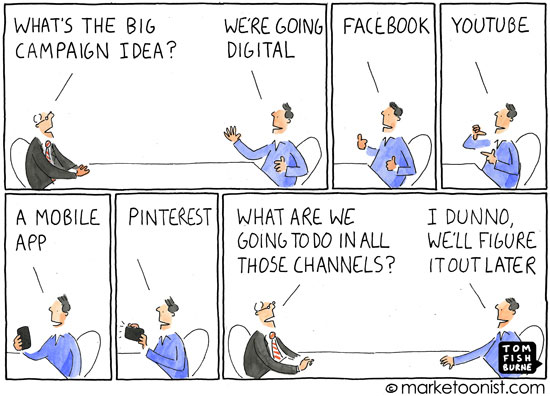Years ago, new design applications like Quark Xpress, Aldus PageMaker and Adobe Illustrator supposedly turned anyone with a mouse into a graphic artist. These days, practically anyone with a Facebook page can pass for a social media consultant; launch an Instagram or Pinterest account and you’re well on your way to full-fledged “guru” status. Toolkits on Pandora and Google can pinpoint audiences that make advertising placement a snap.
Voila! You’re a digital marketer.
Spending on digital media by US financial institutions will top $7 billion in 2015, a 14.5% gain over 2014, according to a report from eMarketer. A healthy 11.7% compound annual growth rate is projected between 2014 and 2019, when the banking industry’s spending on “digital marketing” will top $10 billion annually.
It’s not hard to see why “digital” is the go-to medium for marketing execs. It’s popular, measurable and economical. And it’s sexy.
But the rush to all things “digital” is suffocating the strategic marketing process at many banks and credit unions. Digital marketing, with its obsession on immediacy and instant gratification, can actually undermine long-term growth and brand cultivation.
Services that scale with you. Unlock the potential of your financial institution's digital future with Arriba Advisors. Chart a course for growth, value and superior customer experiences.

Fractional Marketing for Financial Brands

Are You Ready for a Digital Transformation?
Putting the Cart Before the Horse
“But digital marketing is the future!” you may scoff.
Hold your guffaws. Think about all the times your institution’s emphasis on quarterly profits has come at the expense of your brand… and, in turn, your long-term profitability. Think about all the times you’ve rushed to adopt a trend (like maybe Foursquare), only to realize later it was a diversion — a distraction from your core marketing strategy.
“Call it the ethos of the modern digital marketer, or call it youthful ignorance,” says digital consultant Jeff Sauer. “There is very little thought given to the strategies behind most digital marketing efforts. Most efforts employ a spray-and-pray or ready-fire-aim approach. Throw sh*t on the wall and see if it sticks.”
A smattering of social media postings, Facebook campaigns, Pandora ads, and a smattering of blog posts does not supplant strategy. “Strategy” starts several steps up the ladder — asking smart questions about the audience, their habits, their banking goals. And your priorities for branding.
Key Questions: What image are you trying to project? How does your approach to digital channels help you deliver on that promise? Have you truly linked your digital marketing strategies to your organization’s business objectives?
“Spray and pray” was supposed to be the old, antiquated model. “Digital” was supposed to mark the era of awakening. But “digital marketing” seems to be shoving strategy to the back seat… along with other productive channels — direct mail, newspaper, public relations and other traditional media vehicles which are no longer vogue.
Digital marketers have taken Nike’s “Just Do It” to heart. Their popular slogan isn’t just a marketing tagline anymore; it has become marketing gospel.
Ironically, just as financial institutions find themselves tempted to brusquely push aside traditional (and effective) vehicles, digital superbrands like Apple, Facebook and Google are returning to media channels that have been dismissed as “dead” — e.g., direct mail. They recognize that DM can be useful for specific tasks and audience segments.
Ditto: event marketing, newsletters and television.
We’ve read about the decline of TV, but you can’t argue with the facts: it’s still the biggest “player in stadium.” TV is viewed by 283 million television consumers monthly, each watching an average of 146 hours! That compares with 155 million online video viewers averaging almost six hours monthly on mobile, and almost six and a half hours over the Web. The amount spent on digital isn’t even 5% of the mammoth $74 billion chunk of change in television (source: Adweek).
Traditional marketing may not be “trendy,” but trendy is only important to the digiterati — those wanting to be first, hip or otherwise relevant in a Kardashian look-at-me universe. For many of us, “omni-channel marketing” is not just a catch phrase, it’s a philosophy that governs our marketing and communication efforts. Omni-channel marketing is delivering services and messages through channels preferred by customers. Sometimes, it requires traditional media, but it always requires strategy.







